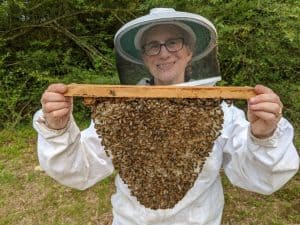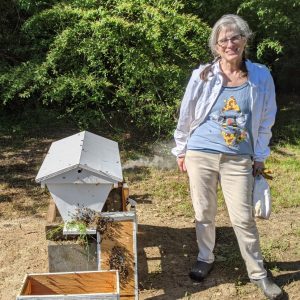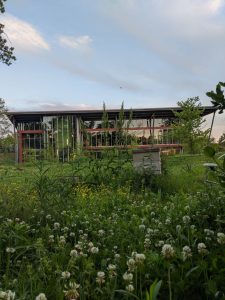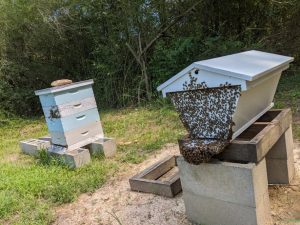calsfoundation@cals.org
The Secret Life of Library Bees
Beekeeping and Sustainability Education for Young People
 If you’ve never visited our Hillary Rodham Clinton Children’s Library, you need to know about this unique treasure in the heart of Little Rock. The CALS Children’s Library was designed in a six-acre natural setting to help young people learn about the natural world and sustainable living.
If you’ve never visited our Hillary Rodham Clinton Children’s Library, you need to know about this unique treasure in the heart of Little Rock. The CALS Children’s Library was designed in a six-acre natural setting to help young people learn about the natural world and sustainable living.
On the grounds of the Children’s Library are a greenhouse and a teaching garden, as well as a large array of solar panels to assist children in learning about sustainable energy. The garden provides produce that is used in the library’s teaching kitchen. Paths wind through a landscape based on Arkansas ecology that includes water, plant life of many kinds, and hives with bees.
Real live bees, with queens and honey and all! Many children develop an understandable fear of bees after warnings from parents about how to avoid stings. But bees and other pollinators fulfill a vital function in our ecosystem—and bees are under threat. Because human life is dependent on pollinators, teaching young people to value and protect bees is a crucial part of their education as they grow up.
Bees on the move
 The library bees usually live in a hive along one of the pathways near the greenhouse, but when the library recently received a grant to install a Storywalk, the bees needed a temporary home to hold them during construction. Just as importantly, they needed someone who understood how to move a beehive safely and humanely.
The library bees usually live in a hive along one of the pathways near the greenhouse, but when the library recently received a grant to install a Storywalk, the bees needed a temporary home to hold them during construction. Just as importantly, they needed someone who understood how to move a beehive safely and humanely.
Enter Patrice O’Donoghue, our Cataloging Librarian. Her hidden superpower is that she is also an experienced beekeeper.
“I first got into beekeeping because my husband was really interested, and in our old house we had a place where we could keep them,” O’Donoghue said. “We took a three-night course with the Central Arkansas Beekeepers Association, and met a lot of beekeepers that way. And then we just got hooked!”
O’Donoghue had the know-how to move a hive of bees without destroying it or confusing the bees so much that they can’t find their relocated hive.
“Bees have this really interesting way of finding directions based on where the sun is, but researchers know that they also see things like trees and buildings,” she said. “So you can either move the bees a few feet every few days, or move them a few miles away all at once. As beekeepers say, it has to be either 3 feet or 3 miles. So that’s what we did, and now my cucumbers are very happy and the bees are happy.”
 Keeping hives healthy
Keeping hives healthy
O’Donoghue currently has several bee yards, or apiarys, and she experiences both the rewards and the challenges of caring for bees in a world with a number of hazards that can threaten colonies. Though her hives often thrive, they also face problems known to all beekeepers.
“Last year, I harvested some honey from them, and I went out a month and a half later and they were doing terribly,” O’Donoghue said. “I decided that it was probably a pesticide poisoning. The bees will go find a place to get their nectar and pollen, and they don’t realize if it’s a place that’s poisoned. Then they all follow each other there and get the same poison. So I went out and found all these dead bees in the front of my hive.”
Other pests such as small hive beetles and varroa mites can also threaten the bees. “If you have a really healthy colony of bees, they can take care of beetles,” she said. “But if your bees get weakened in one of several ways, such as pesticides, they’re more vulnerable to these other threats.”
How to help pollinators
One of the most valuable tips that beekeepers have for youth and adults is that we can all help save bees by the choices we make in our own backyards.
“After I lost those bees, I started paying closer attention to what was happening nearby,” O’Donoghue said. “I have neighbors who have a really nice yard, and they’ve been really cooperative. They were spraying for mosquitoes, and obviously none of us like mosquitoes, but if a chemical will kill mosquitoes, it will kill other insects too. So we worked with our neighbor and showed him some other things we’ve used that were good against mosquitoes but don’t harm bees.”
 What people grow in their backyards can also support pollinators. “It’s good if we can tolerate some clover or some dandelions, because those are things that help the bees,” O’Donoghue said.
What people grow in their backyards can also support pollinators. “It’s good if we can tolerate some clover or some dandelions, because those are things that help the bees,” O’Donoghue said.
Of course, what every child and plenty of adults want to know about beekeeping is how often you get stung.
O’Donoghue smiled. “Probably about every time I inspect them, one or two stings. In the summertime I inspect them about once a week, to make sure they are healthy, and that they have a queen. I don’t have to see the queen, I just have to look for evidence that she’s there: eggs or larvae. I make sure I have a good population and that there’s enough space for them to store their honey. I also may see if it’s time to harvest the honey, and make sure the equipment is good and that there aren’t any ants or beetles.”
Some hives are easier to manage than others. “Each hive can have a different personality or different characteristics,” she explained. “Some kinds are more resistant to diseases, or they might produce more honey, or they might be gentler. And experienced beekeepers might be willing to tolerate a more aggressive bee because they produce more honey.”
O’Donoghue looks forward to the time when the library bees can return to their home. “I’d love to see them back as soon as we can get them situated. We have a good spot near the vegetable garden.”
For more on how you can help support pollinators, please see this tip sheet from the EPA. Below, see the queen bee up close in her hive.
How to visit the Hillary Rodham Clinton Children’s Library and Learning Center
The CALS Children’s Library and Learning Center is now open to a limited number of visitors to enable social distancing. The grounds are open for walking. Curbside service is also available for those who prefer it. Visitors inside the library must wear masks for their own safety and that of others. All children under 16 must be accompanied by an adult. The library is open on Mondays, Wednesdays, and Fridays to the general public from 1-5 p.m. The morning hour from 9-10 a.m. on M/W/F is reserved for patrons 65 years old and up, and those who are immunocompromised.
For more information about how to visit and what to expect, please call the library.
Our phones at Children’s Library are currently down, but we now have a new temporary phone number. If you need assistance, you can reach us at 501.320.5797, or please shoot us an email at childrenscurbside@cals.org.
Feature by Rosslyn Elliott
Photos and video courtesy of Patrice O’Donoghue



